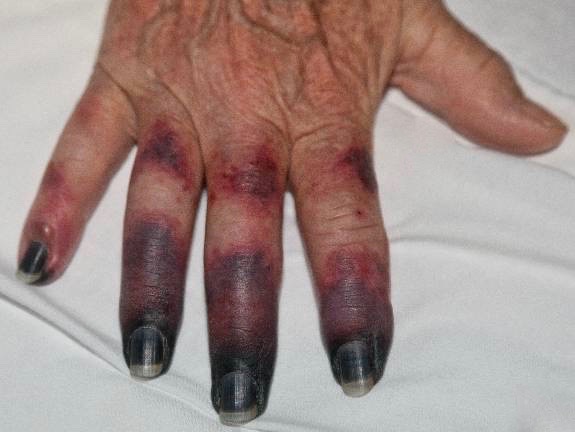Case Presentation:
A 78-year-old white female with sarcomatoid mesothelioma status post gemcitabine and carboplatin presented to an urgent care center with sudden onset of low grade fever and fatigue. She reported a puppy bite 1 week earlier. Examination revealed ½ cm ecchymosis on left forearm at bite site. She was sent home on oral levaquin after routine labs were benign.
Within 48 hours she presented with worsening rash. She denied any history of diarrhea or exposure to seawater. Upon examination, she had nonblanchable purpura on both dorsal forearms, upper arms, calves and thighs. Several of her left toes and right hand digits were notably non tender and purple. Pulses bilaterally palpable with diminished sensations on the respective toes. Due to dramatic progression of the rash within hours and fevers, the patient was hospitalized for further work up with differential diagnosis including autoimmune hemolysis, vasculitis, infection from puppy bite, meningococcemia, disseminated pneumococcus, E-coli or Rickettsia.
DIC, infection, cyroglobuinemia, and rheumatologic work up were negative. She received broad spectrum iv antibiotics and immunoglobulin. Biopsies revealed thrombotic vasculopathy. She was subsequently diagnosed with purpura fulminans with acral vascular necrosis secondary to a paraneoplastic syndrome versus chemotherapy.
Discussion:
Purpura Fulminans with acral gangrene from mesothelioma paraneoplastic syndrome is a rare, life threatening syndrome characterized by rapidly progressive hemolysis and hemorrhagic infarction of the skin. It is usually associated with sepsis or infection and is mainly characterized by small vessel thrombosis, tissue necrosis, and disseminated intravascular coagulation. Erythema, which is rapidly followed by areas of blue‐black hemorrhagic necrosis with a surrounding erythematous border is characteristic. The rash usually precedes the signs of shock. It is a medical emergency and carries a very high mortality rate. Early diagnosis and aggressive treatment combined with supportive management and hemodynamic monitoring is the cornerstone of management
Acral vascular necrosis has been rarely reported as a paraneoplastic syndrome associated with malignancy. There has also been of reports of acral vascular necrosis associated with various chemotherapy agents. A neoplastic origin of acral vascular syndrome should be considered in patients with active malignancy especially if receiving chemotherapy. The treatment of choice is plasmapheresis.
Conclusions:
It is important for hospitalists to consider acral vascular necrosis associated with purpura fulminans in the setting of a cancer patient with rapidly progressive rash. Early diagnosis is of utmost importance related to high morbidity and mortality.
